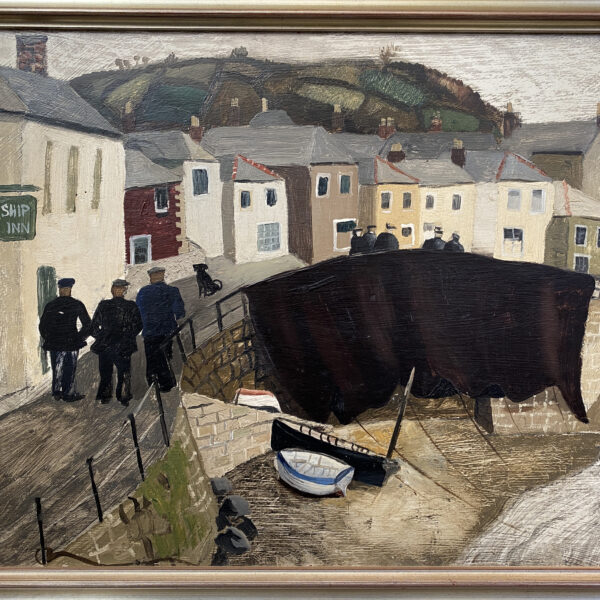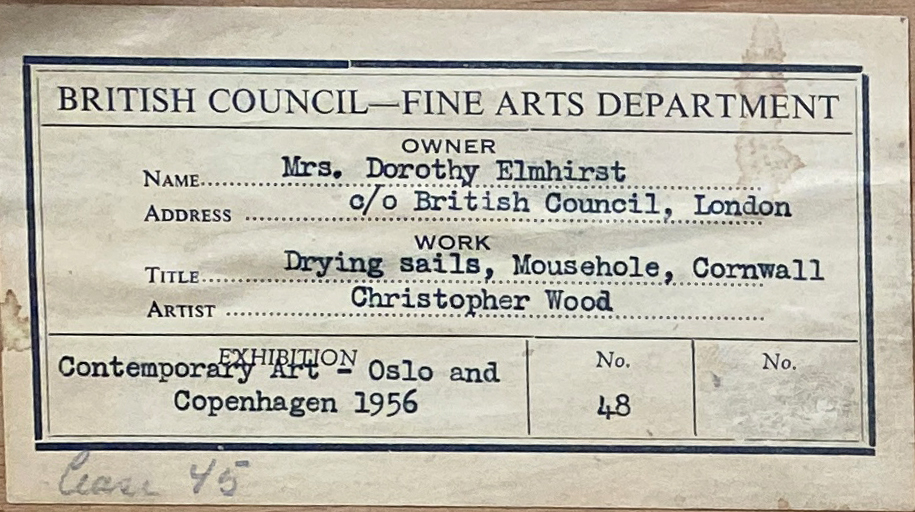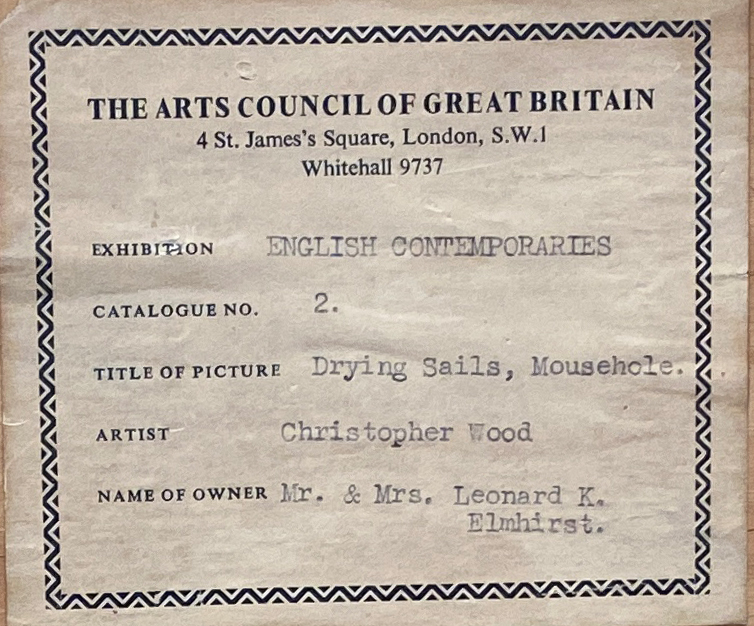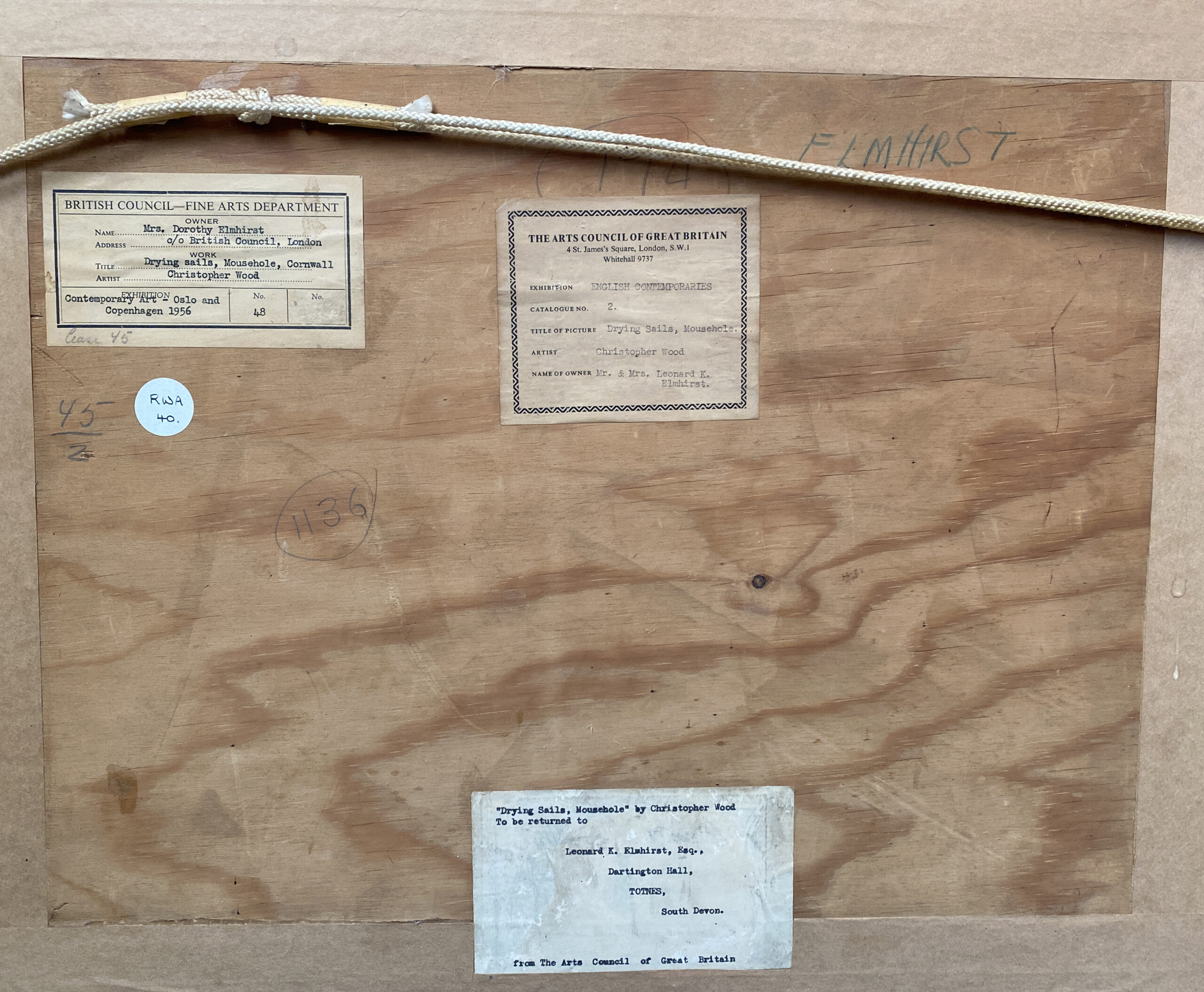Christopher Wood (1901-1930) Drying sails at Mousehole.
Christopher Wood ( 1901-1930)
Drying sails at Mousehole.
Painted on wood panel, depicting houses above the walls of Mousehole harbour, draped with dark sails and dark figures walking, 40cm x 50cm, framed 52cm x 62cm.
Exhibited
London, The New Burlington Galleries, Christopher Wood, Exhibition of Complete Works, 3 March-2 April 1938, cat.no.37
London, The Arts Council of Great Britain, English Contemporaries, 1949, cat.no.2
Copenhagen, Kunstforeninger, British Arts 1900-1955, 10-29 April 1956, cat.no.48; this exhibition travelled to Oslo, Kunstnernes Hus, 12 May-10 June
Literature
Eric Newton, Christopher Wood, The Redfern Gallery, London, 1938, cat.no.437
In 1928 Christopher Wood made the decision to join Ben and Winifred Nicholson in Cornwall, rather than return to Paris. He had first travelled to the French capital in 1921 at the age of 20 and his visits had provided invaluable opportunities to observe the finest examples of Post-Impressionism, Cubism and Fauvism. As a result he was familiar with the work of Van Gogh, Gauguin, Cezanne, Matisse and of course Picasso and Jean Cocteau, both of whom he had known and taken lessons with. This time on the continent taught Wood that simplicity and refinement were the essential characteristics of modern art, and it brought a deep understanding of and appreciation for the Primitive movement, which he strove to emulate in his work over the following years in a very English manner.
It was during this initial trip to Cornwall, far from the avant-garde artists of Europe, that Christopher Wood and Ben Nicholson were to find their ultimate expression of primitive painting in the form of Alfred Wallis, an 80-year-old retired fisherman and self-taught artist who lived at Number 3 Back Road West in St Ives. Within his home were numerous pictures of ships, lighthouses and harbours painted on a variety of irregular cardboard, paper and other salvaged material with distinctive naivety. This now legendary ‘discovery’ was to have a profound effect and invigorated both artists who sought to absorb the lessons of the elderly mariner by leaving their lodgings in Feock to move closer to St Ives, with Wood settling at Meadow Cottage overlooking Porthmeor Beach. It was from this location and following almost daily trips to Wallis that Wood wrote to his mother, ‘I feel my things are becoming really vital and the studentship has passed, my work is forming something quite personal and sure, unlike anybody else’s, and I don’t think anyone can paint the pictures I am doing.’ (Christopher Wood quoted in Katy Norris, Christopher Wood, Lund Humphries in association with Pallant House Gallery, London, 2016, p.109).
Having immersed himself in a seafaring culture which spoke to him, Wood crossed the Channel and spent several months in the fishing village of Treboul in Brittany during 1929. As well as the everyday lives of its inhabitants, many of the images he created are deeply personal and reflect on local customs of the maritime community, observing instances of religious contemplation and festive celebration with both intensity and dignity. The epiphany that had occurred upon meeting Alfred Wallis and the lessons learnt from the nautical communities of northern France were developed in the artist’s final visit to Cornwall prior to his untimely death, where he based himself in the tiny village of Mousehole. During March 1930 he worked solidly here for two weeks and described himself to Ben Nicholson as being ‘absolutely deliriously happy painting’ amongst the narrow grey streets and fishing boats (Christopher Wood quoted in Richard Ingleby, Christopher Wood: An English Painter, Allison & Busby, London, 1995, p.231).
Drying Sails, Mousehole, Cornwall belongs to the group of works painted during this busy time and shows the progression of the artist’s naïve, figurative style which is entirely unique. It exudes a sense of calm as groups of figures amble along the quay past the Ship Inn, which remains to this day. There can be little doubt this is a fishing community with the large sail strewn across the wall, drying from a recent fishing trip, possibly treacherous given the time of year and in stark contrast to the current atmosphere. The carefully observed structure of the boats is a technique that had been honed on a previous visit to Dieppe, along with the scratching and incising of the painted surface. The flashes of colour both here and in other selected passages of the composition act in contrast to the black, white, grey and brown palette that pervades. This simple clarity of colour and form came from the artist’s immediate instinct for his subjects and also the teachings of Wallis who conveyed the essential reduction of these components. Drying Sails, Mousehole, Cornwall is closely related to Ship Inn, Mousehole, completed at the same time and in the collection of Manchester City Galleries.








